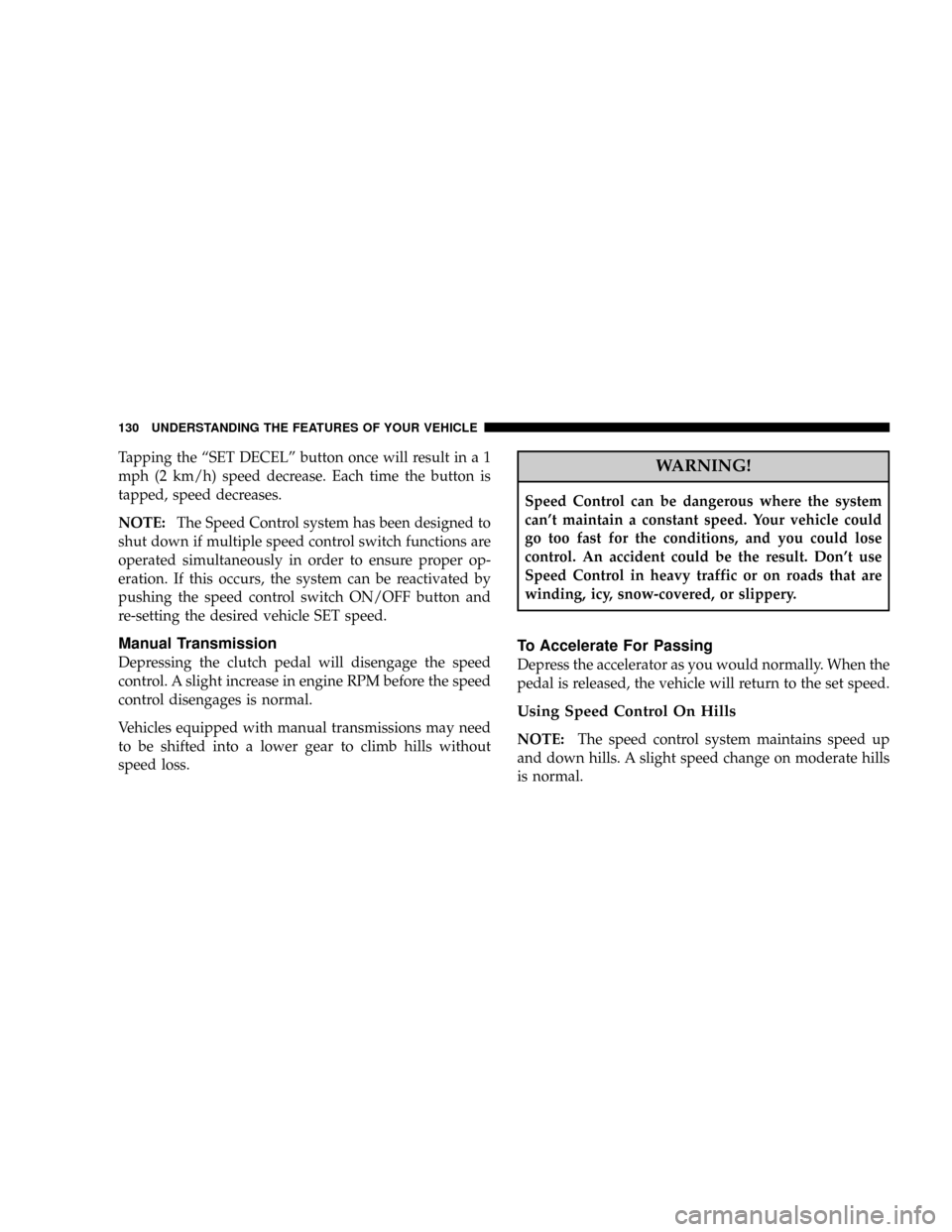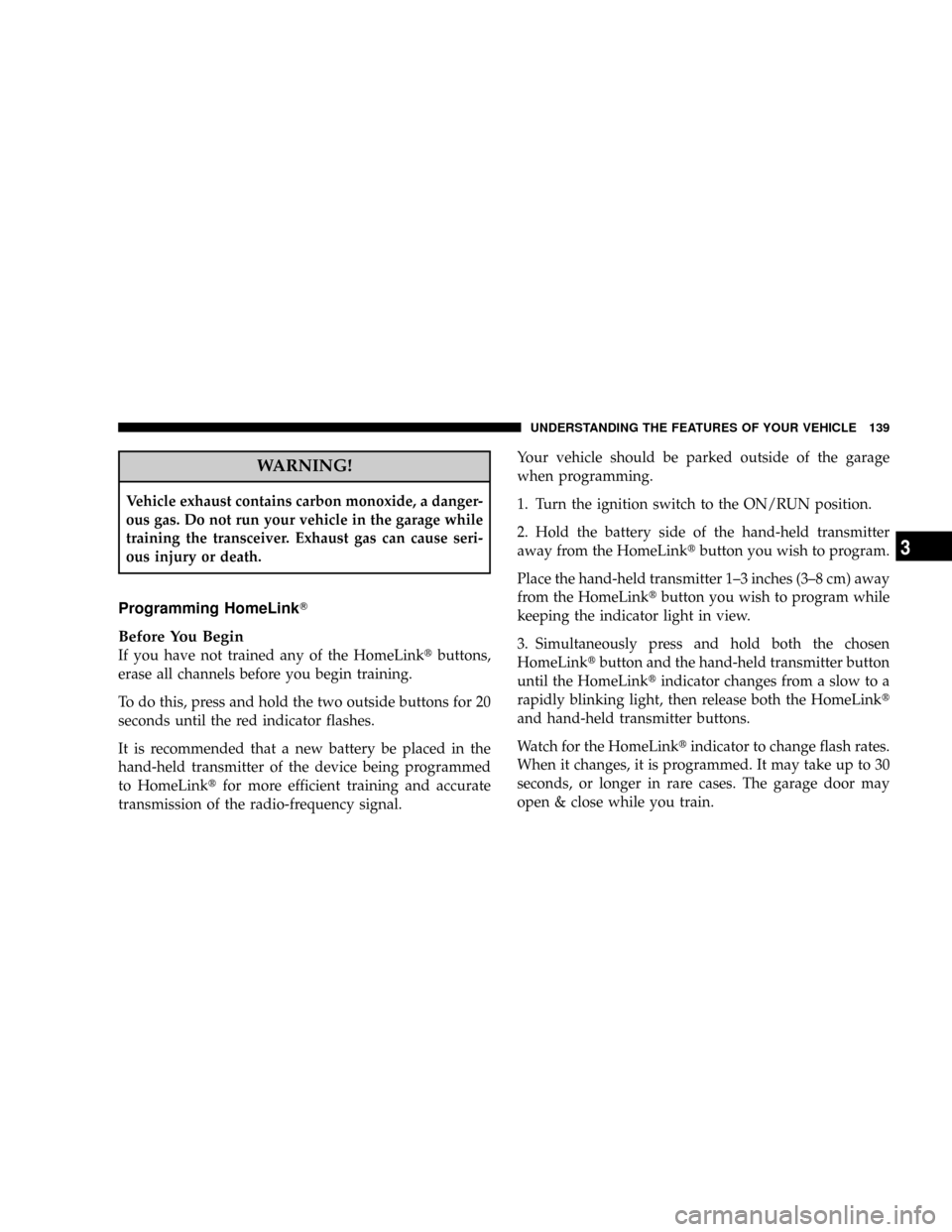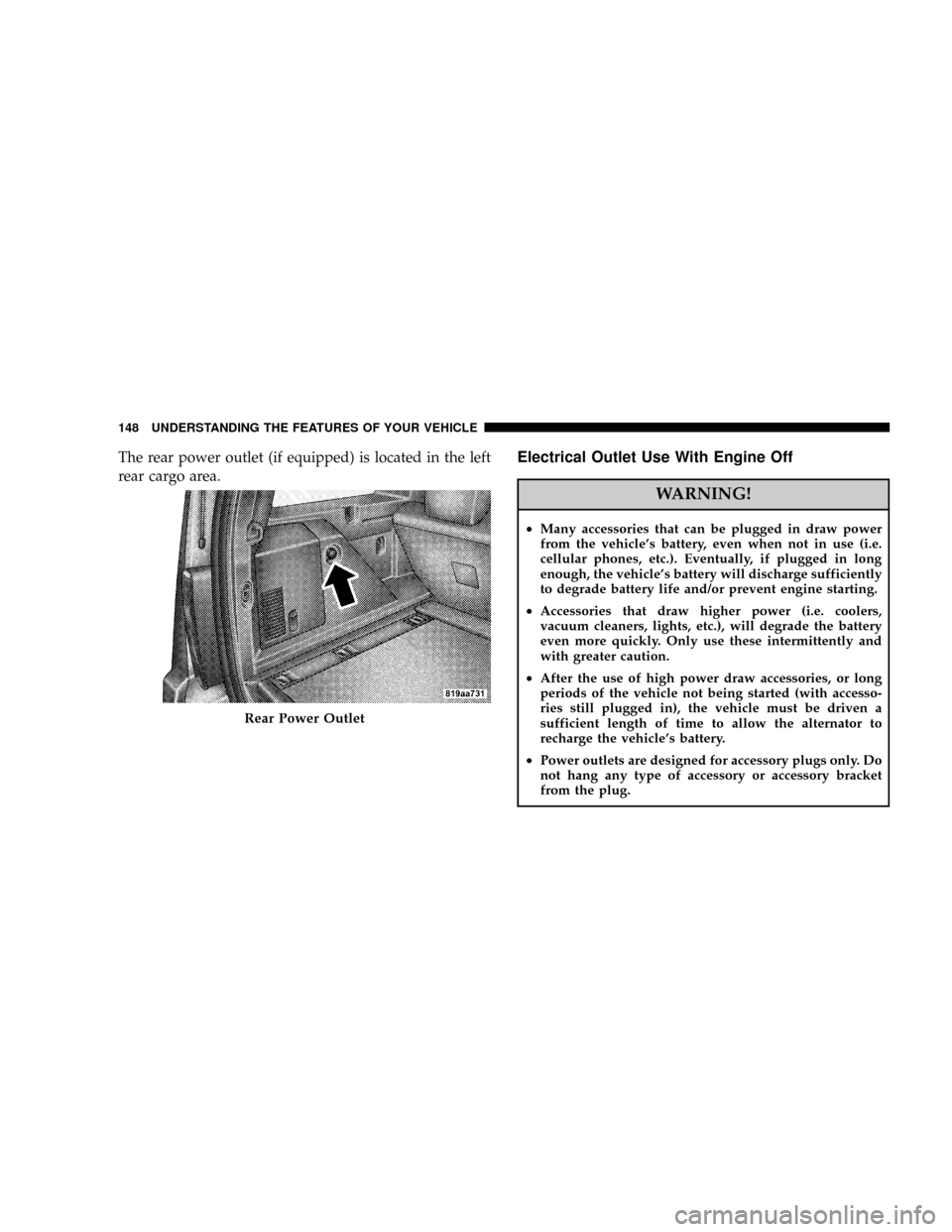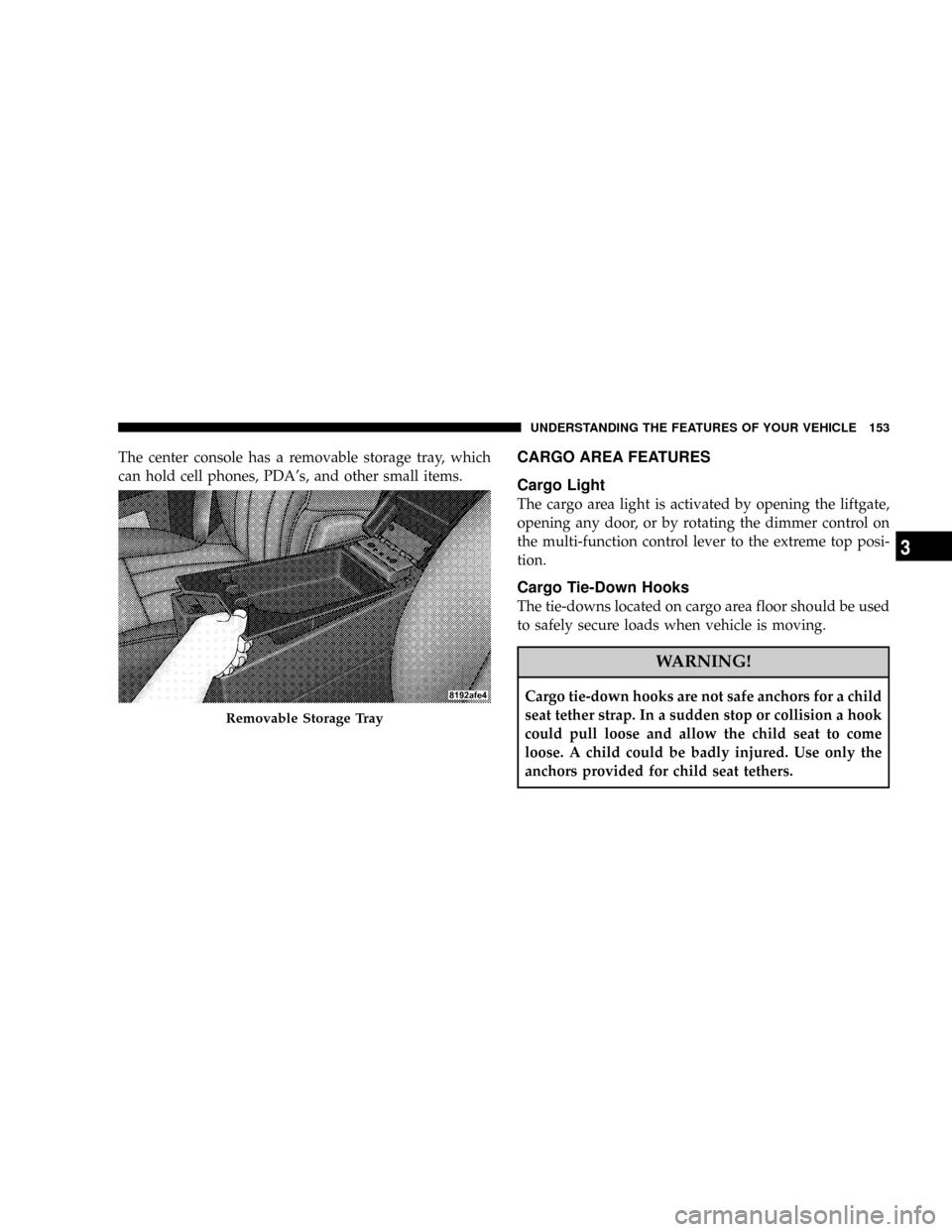warning light DODGE NITRO 2008 1.G User Guide
[x] Cancel search | Manufacturer: DODGE, Model Year: 2008, Model line: NITRO, Model: DODGE NITRO 2008 1.GPages: 434, PDF Size: 6.2 MB
Page 130 of 434

Tapping the ªSET DECELº button once will result in a 1
mph (2 km/h) speed decrease. Each time the button is
tapped, speed decreases.
NOTE:The Speed Control system has been designed to
shut down if multiple speed control switch functions are
operated simultaneously in order to ensure proper op-
eration. If this occurs, the system can be reactivated by
pushing the speed control switch ON/OFF button and
re-setting the desired vehicle SET speed.
Manual Transmission
Depressing the clutch pedal will disengage the speed
control. A slight increase in engine RPM before the speed
control disengages is normal.
Vehicles equipped with manual transmissions may need
to be shifted into a lower gear to climb hills without
speed loss.
WARNING!
Speed Control can be dangerous where the system
can't maintain a constant speed. Your vehicle could
go too fast for the conditions, and you could lose
control. An accident could be the result. Don't use
Speed Control in heavy traffic or on roads that are
winding, icy, snow-covered, or slippery.
To Accelerate For Passing
Depress the accelerator as you would normally. When the
pedal is released, the vehicle will return to the set speed.
Using Speed Control On Hills
NOTE:The speed control system maintains speed up
and down hills. A slight speed change on moderate hills
is normal.
130 UNDERSTANDING THE FEATURES OF YOUR VEHICLE
Page 135 of 434

²Oversteer - when the vehicle is turning more than
appropriate for the steering wheel position.
²Understeer - when the vehicle is turning less than
appropriate for the steering wheel position.
ESP/TCS Indicator Light
The9ESP/TCS Indicator Light9located in the
instrument cluster, starts to flash as soon as the
tires lose traction and the ESP system becomes
active. The9ESP/TCS Indicator Light9also
flashes when TCS is active. If the9ESP/TCS Indicator
Light9begins to flash during acceleration, ease up on the
accelerator and apply as little throttle as possible. Be sure
to adapt your speed and driving to the prevailing road
conditions.
WARNING!
ESP (Electronic Stability Program) cannot prevent the
natural laws of physics from acting on the vehicle,
nor can it increase the traction afforded by prevailing
road conditions. ESP cannot prevent accidents, in-
cluding those resulting from excessive speed in
turns, driving on very slippery surfaces, or hydro-
planing. Only a safe, attentive, and skillful driver can
prevent accidents. The capabilities of an ESP-
equipped vehicle must never be exploited in a reck-
less or dangerous manner which could jeopardize the
user's safety or the safety of others.
The ESP system has 2 available operating modes in 2WD,
4WD Part Time, 4WD Full Time, and on 2WD vehicles.
UNDERSTANDING THE FEATURES OF YOUR VEHICLE 135
3
Page 137 of 434

situation requiring ESP to be switched to the ªPartial Offº
mode is overcome, turn ESP back on by momentarily
depressing the ªESP OFFº switch. This may be done
while the vehicle is in motion.
ESP/BAS Warning Lamp
The malfunction indicator lamp for the ESP is
combined with BAS. The ªESP/BAS Warning
Lampº and the ªESP/TCS Indicator Lightº in
the instrument cluster both come on when the
ignition switch is turned to the ªONº position. They
should go out with the engine running. If the ªESP/BAS
Warning Lampº comes on continuously with the engine
running, a malfunction has been detected in either the
ESP or the BAS system. If this light remains on after
several ignition cycles, and the vehicle has been driven
several miles at speeds greater than 30 mph (48 km/h),
see your authorized dealer as soon as possible to have the
problem diagnosed and corrected.NOTE:
²9The9ESP/TCS Indicator Light9and the9ESP/BAS
Warning Lamp9come on momentarily each time the
ignition switch is turned ON.
²Each time the ignition is turned ON, the ESP System
will be ON even if it was turned off previously.
²The ESP Control System will make buzzing or clicking
sounds when it is active. This is normal; the sounds
will stop when ESP becomes inactive following the
maneuver that caused the ESP activation.
GARAGE DOOR OPENER Ð IF EQUIPPED
HomeLinktreplaces up to three remote controls (hand
held transmitters) that operate devices such as garage
door openers, motorized gates, lighting, or home security
systems. The HomeLinktunit operates off your vehicle's
battery.
UNDERSTANDING THE FEATURES OF YOUR VEHICLE 137
3
Page 139 of 434

WARNING!
Vehicle exhaust contains carbon monoxide, a danger-
ous gas. Do not run your vehicle in the garage while
training the transceiver. Exhaust gas can cause seri-
ous injury or death.
Programming HomeLinkT
Before You Begin
If you have not trained any of the HomeLinktbuttons,
erase all channels before you begin training.
To do this, press and hold the two outside buttons for 20
seconds until the red indicator flashes.
It is recommended that a new battery be placed in the
hand-held transmitter of the device being programmed
to HomeLinktfor more efficient training and accurate
transmission of the radio-frequency signal.Your vehicle should be parked outside of the garage
when programming.
1. Turn the ignition switch to the ON/RUN position.
2. Hold the battery side of the hand-held transmitter
away from the HomeLinktbutton you wish to program.
Place the hand-held transmitter 1±3 inches (3±8 cm) away
from the HomeLinktbutton you wish to program while
keeping the indicator light in view.
3. Simultaneously press and hold both the chosen
HomeLinktbutton and the hand-held transmitter button
until the HomeLinktindicator changes from a slow to a
rapidly blinking light, then release both the HomeLinkt
and hand-held transmitter buttons.
Watch for the HomeLinktindicator to change flash rates.
When it changes, it is programmed. It may take up to 30
seconds, or longer in rare cases. The garage door may
open & close while you train.
UNDERSTANDING THE FEATURES OF YOUR VEHICLE 139
3
Page 148 of 434

The rear power outlet (if equipped) is located in the left
rear cargo area.Electrical Outlet Use With Engine Off
WARNING!
²Many accessories that can be plugged in draw power
from the vehicle's battery, even when not in use (i.e.
cellular phones, etc.). Eventually, if plugged in long
enough, the vehicle's battery will discharge sufficiently
to degrade battery life and/or prevent engine starting.
²Accessories that draw higher power (i.e. coolers,
vacuum cleaners, lights, etc.), will degrade the battery
even more quickly. Only use these intermittently and
with greater caution.
²After the use of high power draw accessories, or long
periods of the vehicle not being started (with accesso-
ries still plugged in), the vehicle must be driven a
sufficient length of time to allow the alternator to
recharge the vehicle's battery.
²Power outlets are designed for accessory plugs only. Do
not hang any type of accessory or accessory bracket
from the plug.
Rear Power Outlet
148 UNDERSTANDING THE FEATURES OF YOUR VEHICLE
Page 153 of 434

The center console has a removable storage tray, which
can hold cell phones, PDA's, and other small items.CARGO AREA FEATURES
Cargo Light
The cargo area light is activated by opening the liftgate,
opening any door, or by rotating the dimmer control on
the multi-function control lever to the extreme top posi-
tion.
Cargo Tie-Down Hooks
The tie-downs located on cargo area floor should be used
to safely secure loads when vehicle is moving.
WARNING!
Cargo tie-down hooks are not safe anchors for a child
seat tether strap. In a sudden stop or collision a hook
could pull loose and allow the child seat to come
loose. A child could be badly injured. Use only the
anchors provided for child seat tethers.
Removable Storage Tray
UNDERSTANDING THE FEATURES OF YOUR VEHICLE 153
3
Page 166 of 434

INSTRUMENT PANEL AND CONTROLS
1 Ð Air Outlet 6 Ð Glove Box 11 Ð Hazard Warning Flasher
2 Ð Instrument Cluster 7 Ð Climate Control 12 Ð * Electronic Stability Control /
Traction Control Switch
3 Ð Storage Tray8 Ð * Heated Seat Switch 13 Ð Cigar Lighter / Power Outlet
4 Ð Center Air Outlet9 Ð * Rear Park Assist Switch 14 Ð Storage Bin
5 Ð Radio 10 Ð Passenger Airbag Disable Light * Ð If Equipped 166 INSTRUMENT PANEL AND CONTROLS
Page 168 of 434

INSTRUMENT CLUSTER DESCRIPTION
1. Fuel Gauge
The fuel gauge shows level of fuel in tank when
ignition switch is in the ON position.
2. Fuel Cap Indicator
This symbol indicates the side of the vehicle
where the fuel cap is located.
3. Temperature Gauge
The temperature gauge indicates engine coolant
temperature. Any reading within the normal
range indicates that the cooling system is operat-
ing satisfactorily. The gauge needle will likely indicate a
high temperature when driving in hot weather, up moun-
tain grades, in heavy traffic, or when towing a trailer. If
the needle rises to the ªHº mark, stop the vehicle, shiftinto N (Neutral) increase engine speed for 2-3 minutes. If
the temperature reading does not return to normal, seek
authorized service immediately.
CAUTION!
Do not leave your vehicle unattended with the en-
gine running as you would not be able to react to the
temperature indicator if the engine overheats.
The gauge pointer will remain near its last reading when
the engine is turned off. It will return to a true reading
when the engine is restarted.
4. Low Fuel Warning Light
This indicator lights when the fuel gauge reads 1/8
of a tank or less.
168 INSTRUMENT PANEL AND CONTROLS
Page 169 of 434

5. Seat Belt Reminder Light
This light comes on for several seconds after the
ignition is turned ON as a reminder to ªbuckle
up.º This light will remain on as long as the driver
or passengers seat belt remains unbuckled. If the seat belt
indicator remains on and/or flashes with belts buckled,
this may indicate a fault in the seat belt reminder system.
Have the system checked by an authorized dealer.
6. Coolant Temperature Warning Light
This light warns of an overheated engine condi-
tion. For a bulb check, this light will come on
momentarily when the ignition is turned On. If the
light turns on while driving, stop the vehicle, shift into N
(Neutral) and increase the engine speed for 2 to 3
minutes. If the temperature reading does not return to
normal, seek authorized service immediately.As temperatures rise and the gauge approaches9H9, this
indicator will illuminate and a single chime will sound
after reaching a set threshold. Further overheating will
cause the temperature gauge to pass9H9, the indicator
will continuously flash, and a continuous chime will
occur until the engine is allowed to cool.
CAUTION!
Driving with a hot engine cooling system could
damage your vehicle. If the temperature light is on,
safely pull over and stop the vehicle. Idle the vehicle
in neutral with the air conditioner turned off until
the light turns off. If the if the light remains on, turn
the engine off immediately, and call for service.
INSTRUMENT PANEL AND CONTROLS 169
4
Page 170 of 434

WARNING!
A hot engine cooling system is dangerous. You or
others could be badly burned by steam or boiling
coolant. You may want to call a service center if your
vehicle overheats. If you decide to look under the
hood yourself, see Section 7 of this manual. Follow
the warnings under the Cooling System Pressure Cap
paragraph.
7. Speedometer
Shows the vehicles speed.
8. High Beam Indicator Light
Indicates that headlights are on high beam.9. Security Alarm System Indicator Light Ð If
Equipped
This light will flash rapidly for approximately 15 seconds
when the vehicle theft alarm is arming. The light will
flash at a slower speed continuously after the alarm is set.
The security light will also come on for about three
seconds when the ignition is first turned on.
10. Electronic Stability Program (ESP) Warning
Light/Brake Assist System (BAS) Warning Light ± If
Equipped
The malfunction lamp for the ESP is combined
with BAS. The yellow ªESP/BAS Warning
Lampº and the yellow ªESP/TCS Indicator
Lightº in the instrument cluster both come on
when the ignition switch is turned to the ªONº position.
They should go out with the engine running. If the
ªESP/BAS Warning Lampº comes on continuously with
the engine running, a malfunction has been detected in
either the ESP or the BAS system. If this light remains on
170 INSTRUMENT PANEL AND CONTROLS